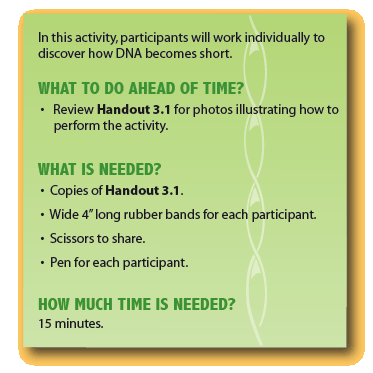
Activity 3.1: DNA: Twisted and Bent Out of Shape?

Directions
DNA strands look very small inside the nucleus of a cell. Why? Give each participant a rubber band. Explain to them that they are about to re-enact an actual, important event in the life of a cell - one that happens each time a cell makes a copy of itself. To learn more about this process also give each participant a pair of scissors, and a pen. These props will allow them to recreate the spectacular "supercoiling of DNA" - an event that occurs in each of the trillions of cells in their bodies as they divide.
Have participants do the following (photos illustrating the exercise can be found in Handout 3.1).
- Cut open the rubber band with the scissors and lay it flat on a hard surface (Photograph 1).
- With the pen, write their name or their email address on their "rubberband DNA".
- Squeeze the ends of the "rubberband DNA" between the thumb and index finger of both hands (Photograph 2).
- Twist the band again and again – the more it is twisted the harder it is to straighten (Photograph 3).
- Once the band is completely twisted, slowly bring the ends of the “rubberband DNA” together until it curls on itself into a mass of tight, overlapping loops (Photograph 4). That is supercoiling!
Explain that twisting, or supercoiling, is what makes DNA appear so small in the picture of the nucleus. Stretched out the DNA in each cell is actually over five feet long!
Ask the participants:
- Talk about the affect you think twisting had on the rubberband?
- What effect do you think twisting might have on the ability of DNA to fit into a very tiny cell (1/200th the size of a pinhead)?
- Describe the difficulties you had reading the information on the rubberband when it was twisted.
- What effect do you think the twisting might have on the access that cellular machinery might have to DNA when it is trying to copy it.